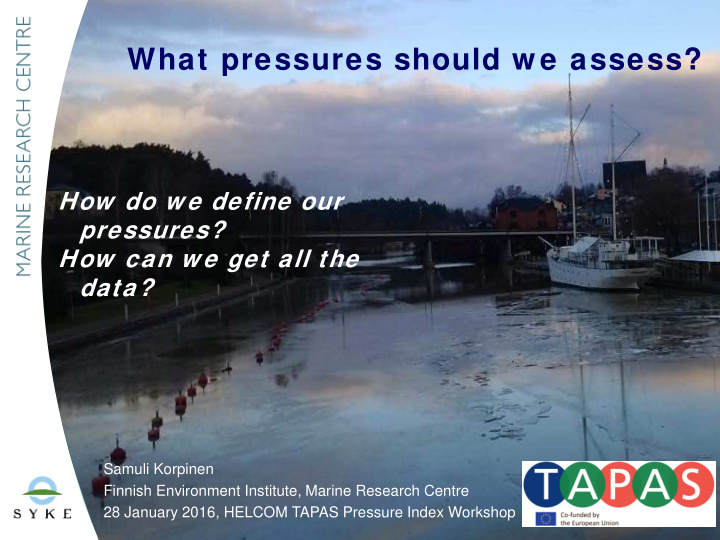



What pressures should w e assess? How do w e define our pressures? How can w e get all the data? Samuli Korpinen Finnish Environment Institute, Marine Research Centre 28 January 2016, HELCOM TAPAS Pressure Index Workshop
The starting points for the pressure data • The MSFD starting points are • the Art 8.1 b: an analysis of the predominant pressures and impacts, including human activity, on the environmental status, • covers the qualitative and quantitative mix of the various pressures • discernible trends, • covers the main cumulative and synergetic effects, • the Annex III Table 2. • The revision of the Annex III a proposal for the Tables 2 a (pressures) and 2 b (activities). • HOLAS II core team defined which pressures and activities are relevant fo rthe Baltic Sea. 2
How can the pressures be linked to human activities? Many pressures are not measured directly, but data on human activities must be used as source data to develop a pressure data layer. Several projects have linked the activities and pressures: - HELCOM HOLAS I, - FP 7 ODEMM, - OSPAR Utrech workshop - EC guidance table in the ’cross-cutting issues’ document - HARMONY project The HELCOM BalticBOOST project made a compilation of these linkages and used that as the background material to make the Document 4. 3
How can the pressure data be prepared from the activity data? Pressures Variable and unit Link to the activity data layer Physical Change of seabed substrate or Area lost (km2) Wind farms (actual area lost in km2) morphology (~ physical loss) Area lost (km2) Cables (actual area lost in km2) Area lost (km2) Pipelines (actual area lost in km2) Area lost (km2) Extraction of sand and gravel (actual area lost in km2) Oil and gas industry infrastructure (actual area lost in Area lost (km2) km2) Area lost (km2) Potting/ creeling (area lost in km2) Area lost (km2) Demersal Scottish seining (area lost in km2) Area lost (km2) Purse seining (area lost in km2) Area lost (km2) Benthic trawling (area lost in km2) Area lost (km2) Demersal seining (area lost in km2) Area lost (km2) Benthic dredging (area lost in km2) Land claim for urban, industrial, leisure, agriculture Area lost (km2) purposes (area lost in km2) 4
Proposal for the variables + units Review the variables and units of Annex 1 of the Document 4 and propose changes if necessary. KEEP IN MIND THAT: The variable+unit should be rather common available 1) from all the countries/datasets. 2) The variable + unit should support the aggregation of data layers to less pressure layers as similar variables + units as possible within a pressure category (Annex III). 3) The variable + unit should be rather similar accross the pressure categories (Annex III) not too complicated data call / data harvesting. 5
Why do w e need to aggregate the pressure data layers? ● Pressure-activity data layers are only technical data layers… what is the real pressure that has impacts on ecosystem? ● Layers should be further aggregated in order to reduce the information needed for setting the impact scores ● Layers that show the same thing should be aggregated in order not to be double-counted in the index ● What aggregations/groups are of particular interest to have in the assessment? Principles for aggregating pressures ● Pressures that can be measured by the same unit can be aggregated ● Rescaling can be used if needed… also to unit-less scales. 6
7
How to estimate the spatial extent of the pressure in relation to particular human activities? Contact zone: 1000m Dilution: logarithmic? 3000m SHIP LANE (vector line) nutrient input QUESTIONS: 1. If a literature study is made, can we ask a review? FISHFARM 2. What would be (vector point) the most nutrient realistic input dilution function? Contact zone: 1000m Dilution: logarithmic? 3000m 8
How to incorporate temporal aspects 1. SEASONALITY : An activity/pressure takes place only seasonally ○ If a species/habitat is inactive that season no impact (e.g. winter impacts on bird breeding area). ○ If a species/habitat is active an impact (e.g. summer impacts on vegetated bays or impacts on seal nursery time). ○ If a species is long-living and impacts accumulate an impact (e.g. contaminants on seals.) 2. FREQUENCY: An activity/pressure is not continuous: ○ If a pressure occurs only irregularly (e.g. capital dredging), e.g. once / 6 year period lesser impact? ○ Should pressure occasions be summed up during the 6 y period? 9
Cases of non-pressure (mitigation, restrictions, environmentally friendly activity, etc.) Mitigation: a shipping company has decided to deliver all waste and waste water to ports. ● Should not be considered as a pressure of nutrient/waste pollution. ● Can we identify these cases in data sets? ● What other mitigation cases are expected? Restrictions: In a country X disposal of dredged material is forbidden near eelgrass meadows. ● Is it enough that the pressure data and eelgrass data do not spatially meet? Can we ensure this in a gridded approach? ● What restriction cases do you identify? 10
How to estimate the spatial extent of the pressure in relation to particular human activities? SHIP LANE (vector line) nutrient input FISHFARM (vector point) nutrient input 1 km 11
Recommend
More recommend